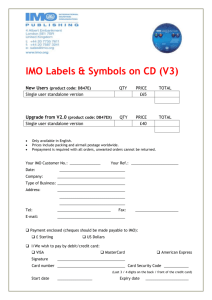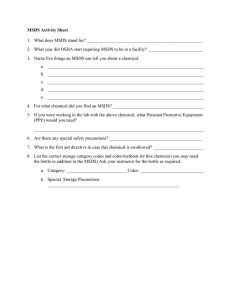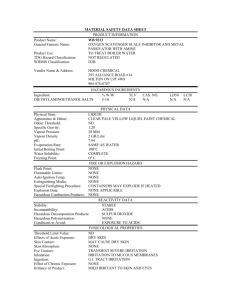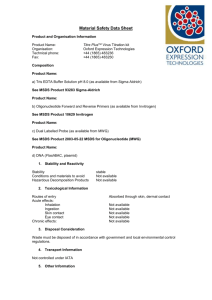Gas Oil Diesel SDS: Hazards, Precautions, & First Aid
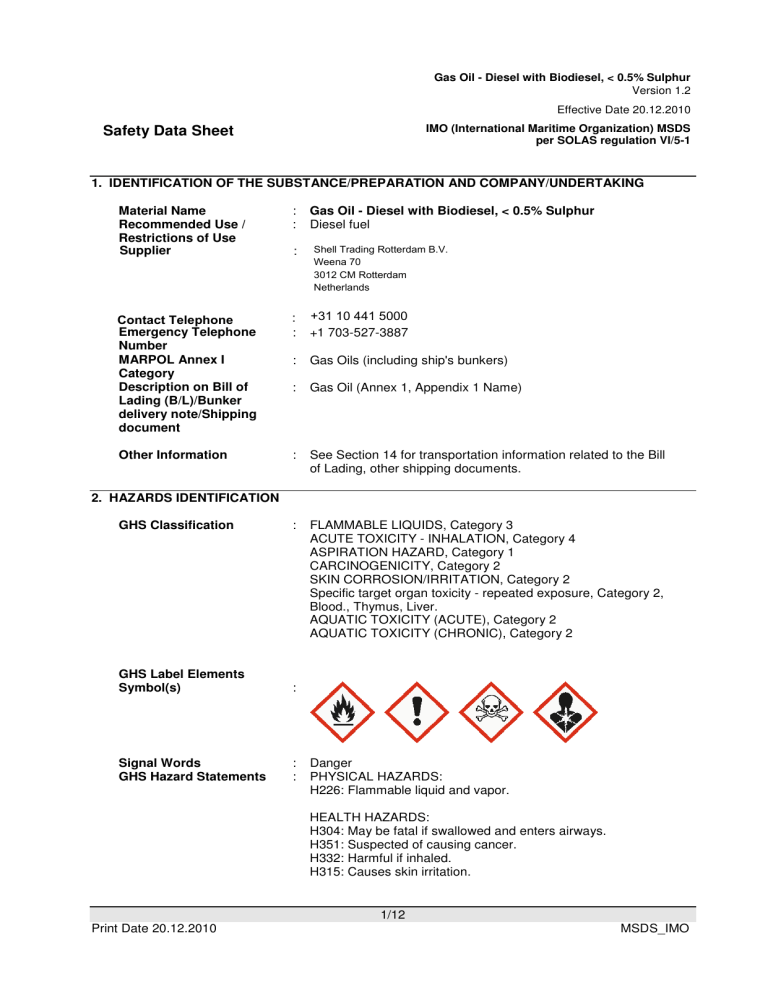
Gas Oil - Diesel with Biodiesel, < 0.5% Sulphur
Version 1.2
Effective Date 20.12.2010
Safety Data Sheet IMO (International Maritime Organization) MSDS per SOLAS regulation VI/5-1
1. IDENTIFICATION OF THE SUBSTANCE/PREPARATION AND COMPANY/UNDERTAKING
Material Name
Recommended Use /
Restrictions of Use
Supplier
: Gas Oil - Diesel with Biodiesel, < 0.5% Sulphur
: Diesel fuel
: Shell Trading Rotterdam B.V.
Weena 70
3012 CM Rotterdam
Netherlands
Contact Telephone
Emergency Telephone
Number
MARPOL Annex I
Category
Description on Bill of
Lading (B/L)/Bunker delivery note/Shipping document
Other Information
:
+31 10 441 5000
: +1 703-527-3887
: Gas Oils (including ship's bunkers)
: Gas Oil (Annex 1, Appendix 1 Name)
: See Section 14 for transportation information related to the Bill of Lading, other shipping documents.
2. HAZARDS IDENTIFICATION
GHS Classification : FLAMMABLE LIQUIDS, Category 3
ACUTE TOXICITY - INHALATION, Category 4
ASPIRATION HAZARD, Category 1
CARCINOGENICITY, Category 2
SKIN CORROSION/IRRITATION, Category 2
Specific target organ toxicity - repeated exposure, Category 2,
Blood., Thymus, Liver.
AQUATIC TOXICITY (ACUTE), Category 2
AQUATIC TOXICITY (CHRONIC), Category 2
GHS Label Elements
Symbol(s) :
: Danger Signal Words
GHS Hazard Statements : PHYSICAL HAZARDS:
H226: Flammable liquid and vapor.
HEALTH HAZARDS:
H304: May be fatal if swallowed and enters airways.
H351: Suspected of causing cancer.
H332: Harmful if inhaled.
H315: Causes skin irritation.
1/12
Print Date 20.12.2010
MSDS_IMO
Safety Data Sheet
Gas Oil - Diesel with Biodiesel, < 0.5% Sulphur
Version 1.2
Effective Date 20.12.2010
IMO (International Maritime Organization) MSDS per SOLAS regulation VI/5-1
H373: May cause damage to organs through prolonged or repeated exposure.
Blood.
Thymus
Liver.
ENVIRONMENTAL HAZARDS:
H401: Toxic to aquatic life.
H411: Toxic to aquatic life with long lasting effects.
GHS Precautionary Statements
Prevention : P210: Keep away from heat/sparks/open flames/hot surfaces.
– No smoking.
Response
P233: Keep container tightly closed.
P240: Ground/bond container and receiving equipment.
P241: Use explosion-proof electrical/ventilating/lighting equipment.
P242: Use only non-sparking tools.
P243: Take precautionary measures against static discharge.
P280: Wear protective gloves/protective clothing/eye protection/face protection.
P261: Avoid breathing dust/fume/gas/mist/vapors/spray.
P271: Use only outdoors or in a well-ventilated area.
P201: Obtain special instructions before use.
P202: Do not handle until all safety precautions have been read and understood.
P273: Avoid release to the environment.
: P303+P361+P353: IF ON SKIN (or hair): Remove/take off immediately all contaminated clothing. Rinse skin with
Storage
Disposal water/shower.
P304+P340: IF INHALED: Remove victim to fresh air and keep at rest in a position comfortable for breathing.
P301+P310: IF SWALLOWED: Immediately call a POISON
CENTER or doctor/physician.
P331: Do NOT induce vomiting.
P308+P313: IF exposed or concerned: Get medical advice/attention.
P391: Collect spillage.
P312: Call a POISON CENTER or doctor/physician if you feel unwell.
P370: In case of fire:
P378: Use appropriate media for extinction.
: P403+P235: Store in a well-ventilated place. Keep cool.
P405: Store locked up.
: P501: Dispose of contents and container to appropriate waste site or reclaimer in accordance with local and national regulations.
Other Hazards which do not result in classification
: May ignite on surfaces at temperatures above auto-ignition temperature. Vapour in the headspace of tanks and containers
2/12
Print Date 20.12.2010
MSDS_IMO
Gas Oil - Diesel with Biodiesel, < 0.5% Sulphur
Version 1.2
Effective Date 20.12.2010
Safety Data Sheet IMO (International Maritime Organization) MSDS per SOLAS regulation VI/5-1 may ignite and explode at temperatures exceeding autoignition temperature, where vapour concentrations are within the flammability range. Electrostatic charges may be generated during pumping. Electrostatic discharge may cause fire.
Hydrogen sulphide is highly toxic and may be fatal if inhaled.
Hydrogen sulphide (H2S), an extremely flammable and toxic gas, and other hazardous vapours may evolve and collect in the headspace of storage tanks, transport vessels and other enclosed containers. May dull the sense of smell and has a high odour threshold, so do not rely on odour as an indication of hazard. H2S has a broad range of effects dependent on the airborne concentration and length of exposure: 0.02 ppm odour threshold, smell of rotten eggs; 10 ppm eye and respiratory tract irritation; 100 ppm coughing, headache, dizziness, nausea, eye irritation, loss of sense of smell in minutes; 200 ppm potential for pulmonary oedema after >20-30 minutes; 500 ppm loss of consciousness after short exposures, potential for respiratory arrest; >1000ppm immediate loss of consciousness, may lead rapidly to death, prompt cardiopulmonary resuscitation may be required. Do not depend on sense of smell for warning. H2S causes rapid olfactory fatigue
(deadens sense of smell). There is no evidence that H2S will
Additional Information accumulate in the body tissue after repeated exposure.
: This product is intended for use in closed systems only.
3. COMPOSITION/INFORMATION ON INGREDIENTS
Preparation Description : Streams obtained from distillation and cracking processes, and containing saturated, olefinic and aromatic hydrocarbons, mainly in the range C9 to C25 and boiling in the range ca. 160 to 400ºC.
Hazardous Components
Contains methyl and ethyl esters from lipid sources.
Chemical Identity
Fuels, diesel
CAS
68334-30-5
Conc.
85.00 - 100.00 %
Fatty acids, C16-18 and C18-unsatd., Me esters
Additional Information :
67762-38-3
Contains Sulphur, CAS # 7704-34-9.
0.00 - 15.00 %
Contains hydrogen sulphide, CAS # 7783-06-4.
Hydrogen sulphide may be present both in the liquid and the vapour. Composition is complex and varies with the source of the crude oil.
4. FIRST AID MEASURES
General Information
Inhalation
: Vaporisation of H2S that has been trapped in clothing can be dangerous to rescuers. Maintain respiratory protection to avoid contamination from the victim to rescuer. Mechanical ventilation should be used to resuscitate if at all possible.
: Remove to fresh air. If rapid recovery does not occur, transport to nearest medical facility for additional treatment.
3/12
Print Date 20.12.2010
MSDS_IMO
Safety Data Sheet
Gas Oil - Diesel with Biodiesel, < 0.5% Sulphur
Version 1.2
Effective Date 20.12.2010
IMO (International Maritime Organization) MSDS per SOLAS regulation VI/5-1
Skin Contact
Eye Contact
Ingestion
Most Important
Symptoms/Effects, Acute
& Delayed
Immediate medical attention, special treatment
5. FIRE FIGHTING MEASURES
: Remove contaminated clothing. Immediately flush skin with large amounts of water for at least 15 minutes, and follow by washing with soap and water if available. If redness, swelling, pain and/or blisters occur, transport to the nearest medical facility for additional treatment.
: Flush eye with copious quantities of water. If persistent irritation occurs, obtain medical attention.
: If swallowed, do not induce vomiting: transport to nearest medical facility for additional treatment. If vomiting occurs spontaneously, keep head below hips to prevent aspiration. If any of the following delayed signs and symptoms appear within the next 6 hours, transport to the nearest medical facility: fever greater than 101° F (37° C), shortness of breath, chest congestion or continued coughing or wheezing. Give nothing by mouth.
: If material enters lungs, signs and symptoms may include coughing, choking, wheezing, difficulty in breathing, chest congestion, shortness of breath, and/or fever.
The onset of respiratory symptoms may be delayed for several hours after exposure.
H2S has a broad range of effects dependent on the airborne concentration and length of exposure: 0.02 ppm odour threshold, smell of rotten eggs; 10 ppm eye and respiratory tract irritation; 100 ppm coughing, headache, dizziness, nausea, eye irritation, loss of sense of smell in minutes; 200 ppm potential for pulmonary oedema after >20-30 minutes; 500 ppm loss of consciousness after short exposures, potential for respiratory arrest; >1000ppm immediate loss of consciousness, may lead rapidly to death, prompt cardiopulmonary resuscitation may be required. Do not depend on sense of smell for warning. H2S causes rapid olfactory fatigue
(deadens sense of smell). There is no evidence that H2S will accumulate in the body tissue after repeated exposure.
: Hydrogen sulphide (H2S) - CNS asphyxiant. May cause rhinitis, bronchitis and occasionally pulmonary oedema after severe exposure. CONSIDER: Oxygen therapy. Consult a
Poison Control Center for guidance. Exposure to hydrogen sulphide at concentrations above the recommended occupational exposure standard may cause headache, dizziness, irritation of the eyes, upper respiratory tract, mouth and digestive tract, convulsions, respiratory paralysis, unconsciousness and even death.
Clear fire area of all non-emergency personnel.
Specific hazards arising from Chemicals
: Hazardous combustion products may include: A complex mixture of airborne solid and liquid particulates and gases
(smoke). Carbon monoxide. Oxides of sulphur. Unidentified organic and inorganic compounds. Carbon monoxide may be evolved if incomplete combustion occurs. Will float and can be reignited on surface water. Flammable vapours may be present even at temperatures below the flash point. Hydrogen sulphide
4/12
Print Date 20.12.2010
MSDS_IMO
Gas Oil - Diesel with Biodiesel, < 0.5% Sulphur
Version 1.2
Effective Date 20.12.2010
Safety Data Sheet IMO (International Maritime Organization) MSDS per SOLAS regulation VI/5-1
Suitable Extinguishing
Media
Unsuitable Extinguishing
Media
(H2S) and toxic sulphur oxides may be given off when this material is heated. Do not depend on sense of smell for warning.
: Foam, water spray or fog. Dry chemical powder, carbon dioxide, sand or earth may be used for small fires only.
: Do not use water in a jet. Simultaneous use of foam and water on the same surface is to be avoided as water destroys the foam.
: Wear full protective clothing and self-contained breathing apparatus.
Protective Equipment &
Precautions for Fire
Fighters
Additional Advice : Keep adjacent containers cool by spraying with water.
6. ACCIDENTAL RELEASE MEASURES
Avoid contact with spilled or released material. For guidance on selection of personal protective equipment see Chapter 8 of this Material Safety Data Sheet.
See Chapter 13 for information on disposal.
Observe the relevant local and international regulations.
Evacuate the area of all nonessential personnel.
Ventilate contaminated area thoroughly.
Personal Precautions,
Protective Equipment and
Emergency Procedures
: Do not breathe fumes, vapour. Do not operate electrical equipment.
Environmental
Precautions
: Shut off leaks, if possible without personal risks. Remove all possible sources of ignition in the surrounding area. Use appropriate containment (of product and fire fighting
Methods and Material for
Containment and Clean
Up water) to avoid environmental contamination. Prevent from spreading or entering drains, ditches or rivers by using sand, earth, or other appropriate barriers. Attempt to disperse the vapour or to direct its flow to a safe location for example by using fog sprays. Take precautionary measures against static discharge. Ensure electrical continuity by bonding and grounding (earthing) all equipment.
: For large liquid spills (> 1 drum), transfer by mechanical means such as vacuum truck to a salvage tank for recovery or safe disposal. Do not flush away residues with water. Retain as contaminated waste. Allow residues to evaporate or soak up with an appropriate absorbent material and dispose of safely.
Remove contaminated soil and dispose of safely.
For small liquid spills (< 1 drum), transfer by mechanical means to a labelled, sealable container for product recovery or safe disposal. Allow residues to evaporate or soak up with an
Additional Advice appropriate absorbent material and dispose of safely. Remove contaminated soil and dispose of safely. Shovel into a suitable clearly marked container for disposal or reclamation in accordance with local regulations.
: Notify authorities if any exposure to the general public or the environment occurs or is likely to occur. Local authorities should be advised if significant spillages cannot be contained.
Maritime spillages should be dealt with using a Shipboard Oil
Pollution Emergency Plan (SOPEP), as required by MARPOL
Annex 1 Regulation 26.
5/12
Print Date 20.12.2010
MSDS_IMO
Safety Data Sheet
7. HANDLING AND STORAGE
General Precautions
Precautions for Safe
Handling
Conditions for Safe
Storage
Product Transfer
Print Date 20.12.2010
Gas Oil - Diesel with Biodiesel, < 0.5% Sulphur
Version 1.2
Effective Date 20.12.2010
IMO (International Maritime Organization) MSDS per SOLAS regulation VI/5-1
: Avoid breathing vapours or contact with material. Only use in well ventilated areas. Wash thoroughly after handling. For guidance on selection of personal protective equipment see
Chapter 8 of this Material Safety Data Sheet.
Use the information in this data sheet as input to a risk assessment of local circumstances to help determine appropriate controls for safe handling, storage and disposal of this material.
Air-dry contaminated clothing in a well-ventilated area before laundering.
Properly dispose of any contaminated rags or cleaning materials in order to prevent fires.
Prevent spillages.
Use local exhaust ventilation if there is risk of inhalation of vapours, mists or aerosols.
Never siphon by mouth.
Contaminated leather articles including shoes cannot be decontaminated and should be destroyed to prevent reuse.
For comprehensive advice on handling, product transfer, storage and tank cleaning refer to the product supplier.
: Avoid inhaling vapour and/or mists.
Electrostatic charges may be generated during pumping. Electrostatic discharge may cause fire.
Extinguish any naked flames. Do not smoke.
Remove ignition sources. Avoid sparks.
Earth all equipment.
Avoid prolonged or repeated contact with skin.
When using do not eat or drink.
The inherent toxic and olfactory (sense of smell) fatiguing properties of hydrogen sulphide require that air monitoring alarms be used if concentrations are expected to reach harmful levels such as in enclosed spaces, heated transport vessels and spill or leak situations. If the air concentration exceeds 50 ppm, the area should be evacuated unless respiratory protection is in use.
The vapour is heavier than air, spreads along the ground and distant ignition is possible.
: Tank storage: Tanks must be specifically designed for use with this product.
Bulk storage tanks should be diked (bunded).
Locate tanks away from heat and other sources of ignition.
Must be stored in a diked (bunded) well-ventilated area, away from sunlight, ignition sources and other sources of heat.
The vapour is heavier than air. Beware of accumulation in pits and confined spaces.
Keep in a bunded area with a sealed (low permeability) floor, to provide containment against spillage.
Prevent ingress of water.
: Avoid splash filling.
Wait 2 minutes after tank filling (for tanks such as those on road tanker vehicles) before opening hatches or manholes.
Wait 30 minutes after tank filling (for large storage tanks) before opening hatches or manholes.
Keep containers closed when not in use.
Do not use compressed air for filling, discharging or handling.
Contamination resulting from product transfer may give rise to light hydrocarbon vapour in the headspace of tanks that have previously contained gasoline. This vapour may explode if there is a source of ignition. Partly filled containers present a greater hazard than those that are full, therefore handling, transfer and sampling
6/12
MSDS_IMO
Gas Oil - Diesel with Biodiesel, < 0.5% Sulphur
Version 1.2
Effective Date 20.12.2010
Safety Data Sheet IMO (International Maritime Organization) MSDS per SOLAS regulation VI/5-1 activities need special care.
Recommended Materials : For containers, or container linings use mild steel, stainless steel.
Aluminium may also be used for applications where it does not present an unnecessary fire hazard.
Examples of suitable materials are: high density polyethylene (HDPE) and
Viton (FKM), which have been specifically tested for
Unsuitable Materials
Other Advice compatibility with this product.
For container linings, use amine-adduct cured epoxy paint.
For seals and gaskets use: graphite, PTFE, Viton A, Viton B.
: Some synthetic materials may be unsuitable for containers or container linings depending on the material specification and intended use. Examples of materials to avoid are: natural rubber (NR), nitrile rubber (NBR), ethylene propylene rubber
(EPDM), polymethyl methacrylate (PMMA), polystyrene, polyvinyl chloride (PVC), polyisobutylene. However, some may be suitable for glove materials.
: Ensure that all local regulations regarding handling and storage facilities are followed.
8. EXPOSURE CONTROLS/PERSONAL PROTECTION
If the American Conference of Governmental Industrial Hygienists (ACGIH) value is provided on this document, it is provided for information only.
Occupational Exposure Limits
Material Source Type ppm mg/m3 Notation
Fuels, diesel ACGIH
ACGIH
TWA
[Inhalable fraction and vapor.]
SKIN_DES
[Inhalable fraction and vapor.]
100 mg/m3 as total hydrocarbons
Can be absorbed through the skin.
as total hydrocarbons
Additional Information : Skin notation means that significant exposure can also occur by absorption of liquid through the skin and of vapour through the eyes or mucous membranes.
Biological Exposure Index (BEI) - See reference for full details
No biological limit allocated.
Appropriate Engineering
Controls
: The level of protection and types of controls necessary will vary depending upon potential exposure conditions. Select controls based on a risk assessment of local circumstances.
Appropriate measures include: Use sealed systems as far as possible.
Adequate ventilation to control airborne concentrations below the exposure guidelines/limits.
Local exhaust ventilation is recommended.
Eye washes and showers
7/12
Print Date 20.12.2010
MSDS_IMO
Gas Oil - Diesel with Biodiesel, < 0.5% Sulphur
Version 1.2
Effective Date 20.12.2010
Safety Data Sheet IMO (International Maritime Organization) MSDS per SOLAS regulation VI/5-1 for emergency use.
Individual Protection
Measures
: Personal protective equipment (PPE) should meet recommended national standards. Check with PPE suppliers.
Respiratory Protection : If engineering controls do not maintain airborne concentrations to a level which is adequate to protect worker health, select respiratory protection equipment suitable for the specific conditions of use and meeting relevant legislation.
Check with respiratory protective equipment suppliers.
Where air-filtering respirators are unsuitable (e.g. airborne concentrations are high, risk of oxygen deficiency, confined space) use appropriate positive pressure breathing apparatus.
Where airfiltering respirators are suitable, select an appropriate
Hand Protection
Eye Protection
Protective Clothing
Thermal Hazards
Monitoring Methods combination of mask and filter.
All respiratory protection equipment and use must be in accordance with local regulations.
: Personal hygiene is a key element of effective hand care.
Gloves must only be worn on clean hands. After using gloves, hands should be washed and dried thoroughly. Application of a non-perfumed moisturizer is recommended.
Suitability and durability of a glove is dependent on usage, e.g. frequency and duration of contact, chemical resistance of glove material, glove thickness, dexterity. Always seek advice from glove suppliers. Contaminated gloves should be replaced.
: Chemical splash goggles (chemical monogoggles).
: Chemical resistant gloves/gauntlets, boots, and apron (where risk of splashing).
: Not applicable.
: Monitoring of the concentration of substances in the breathing zone of workers or in the general workplace may be required to confirm compliance with an OEL and adequacy of exposure controls. For some substances biological monitoring may also be appropriate.
: Local guidelines on emission limits for volatile substances must Environmental Exposure
Controls be observed for the discharge of exhaust air containing vapour.
9. PHYSICAL AND CHEMICAL PROPERTIES
Appearance
Odour
Odour threshold pH
Initial Boiling Point and
Boiling Range
Melting / freezing point
: .
Clear, bright liquid.
: Hydrocarbon
: 200 - 350 °C /
: Data not available
: Data not available
392 - 662 °F
Flash point
Lower / upper
Flammability or
Explosion limits
: Data not available
: > 52 °C / 126
: 0.5 - 4.4 %(V)
°F (ASTM D-93 / PMCC)
Ignition temperature : 254 - 285 °C / 489 - 545 °F
Auto-ignition temperature : 260 °C / 500 °F
Vapour pressure : 4 hPa
Relative Density : 0.85
Density : Data not available
8/12
Print Date 20.12.2010
MSDS_IMO
Gas Oil - Diesel with Biodiesel, < 0.5% Sulphur
Version 1.2
Effective Date 20.12.2010
Safety Data Sheet IMO (International Maritime Organization) MSDS per SOLAS regulation VI/5-1
Bulk density
Water solubility
Solubility in other solvents n-octanol/water partition coefficient (log Pow)
: Data not available
: Negligible.
: 2.66 - 6.0
: Data not available
Dynamic viscosity
Kinematic viscosity
Vapour density (air=1)
Evaporation rate
: Data not available
: > 1.5 - 7.4 mm2/s at 40 °C / 104 °F
: > 1
: Data not available
(nBuAc=1)
Flammability
10. STABILITY AND REACTIVITY
:
: Flammable liquid.
Chemical Stability
Possibility of Hazardous
Reactions
Conditions to Avoid
Incompatible Materials
Hazardous
Decomposition Products
: Stable under normal conditions of use.
: Data not available
: Avoid heat, sparks, open flames and other ignition sources.
: Strong oxidising agents.
: Hazardous decomposition products are not expected to form during normal storage.
Thermal decomposition is highly dependent on conditions. A complex mixture of airborne solids, liquids and gases, including carbon monoxide, carbon dioxide and other organic compounds will be evolved when this material undergoes combustion or thermal or oxidative degradation.
Hydrogen sulphide.
: Not applicable.
Hazardous
Polymerisation
11. TOXICOLOGICAL INFORMATION
Basis for Assessment
Likely Routes of
Exposure
: Information given is based on product data, a knowledge of the components and the toxicology of similar products.
: Skin and eye contact are the primary routes of exposure although exposure may occur through inhalation or following accidental ingestion.
: Low toxicity: LD50 > 5000 mg/kg , Rat Acute Oral Toxicity
Acute Dermal Toxicity : Low toxicity: LD50 >2000 mg/kg , Rabbit
Acute Inhalation Toxicity : Harmful if inhaled.
LC50 > 1.0 - <= 5.0 mg/l Rat
Skin Corrosion/Irritation : Irritating to skin.
Serious Eye
Damage/Irritation
: Expected to be slightly irritating.
Respiratory Irritation : Inhalation of vapours or mists may cause irritation to the respiratory system.
Respiratory or Skin
Sensitisation
: Not expected to be a sensitiser.
9/12
Print Date 20.12.2010
MSDS_IMO
Gas Oil - Diesel with Biodiesel, < 0.5% Sulphur
Version 1.2
Effective Date 20.12.2010
Safety Data Sheet IMO (International Maritime Organization) MSDS per SOLAS regulation VI/5-1
Aspiration Hazard
Germ Cell Mutagenicity
Carcinogenicity
: Aspiration into the lungs when swallowed or vomited may cause chemical pneumonitis which can be fatal.
: Positive in in-vitro, but negative in in-vivo mutagenicity assays.
: Limited evidence of carcinogenic effect.
Repeated skin contact
Reproductive and
Developmental Toxicity has resulted in irritation and skin cancer in animals.
: Not expected to be a developmental toxicant. Not expected to impair fertility.
Specific target organ toxicity - single exposure
Specific target organ toxicity - repeated exposure
12. ECOLOGICAL INFORMATION
: Not expected to be a hazard.
: Causes damage to organs through prolonged or repeated exposure.
Blood.
Thymus Liver.
Basis for Assessment
Acute Toxicity
: Information given is based on a knowledge of the components and the ecotoxicology of similar products.
: Expected to be toxic: LL/EL/IL50 1-10 mg/l (LL/EL50 expressed as the nominal amount of product required to prepare aqueous test extract).
Fish : Toxic: LL/EL/IL50 10-100 mg/l
Aquatic Invertebrates : Toxic: LL/EL/IL50 10-100 mg/l
Algae
Mobility
Microorganisms
: Toxic: LL/EL/IL50 10-100 mg/l
: Expected to be practically non toxic: LL/EL/IL50 > 100 mg/l
: Partly evaporates from water or soil surfaces, but a significant proportion will remain after one day.
If product enters soil, one or more constituents will be mobile and may contaminate groundwater.
Floats on water.
Partly evaporates from water or soil surfaces, but a significant proportion will remain after one day.
Large volumes may penetrate soil and could contaminate groundwater.
Persistence/degradability : Not Persistent per IMO criteria. International Oil Pollution
Compensation (IOPC) Fund definition: “A non-persistent oil is oil, which, at the time of shipment, consists of hydrocarbon fractions, (a) at least 50% of which, by volume, distills at a temperature of 340ºC (645ºF) and (b) at least 95% of which, by volume, distils at a temperature of 370ºC (700ºF) when tested by the ASTM Method D-86/78 or any subsequent revision thereof." Readily biodegradable.
Bioaccumulative : Contains constituents with the potential to bioaccumulate.
Potential
Other Adverse Effects : Films formed on water may affect oxygen transfer and damage organisms.
13. DISPOSAL CONSIDERATIONS
Material Disposal : Recover or recycle if possible.
It is the responsibility of the
10/12
Print Date 20.12.2010
MSDS_IMO
Gas Oil - Diesel with Biodiesel, < 0.5% Sulphur
Version 1.2
Effective Date 20.12.2010
Safety Data Sheet IMO (International Maritime Organization) MSDS per SOLAS regulation VI/5-1
Container Disposal waste generator to determine the toxicity and physical properties of the material generated to determine the proper waste classification and disposal methods in compliance with applicable regulations.
Do not dispose into the environment, in drains or in water courses.
Do not dispose of tank water bottoms by allowing them to drain into the ground. This will result in soil and groundwater contamination.
Waste arising from a spillage or tank cleaning should be disposed of in accordance with prevailing regulations, preferably to a recognised collector or contractor. The competence of the collector or contractor should be established beforehand.
: Send to drum recoverer or metal reclaimer.
Drain container thoroughly.
After draining, vent in a safe place away from
Local Legislation
14. TRANSPORT INFORMATION sparks and fire. Residues may cause an explosion hazard.
Do not, puncture, cut, or weld uncleaned drums.
Do not pollute the soil, water or environment with the waste container.
Comply with any local recovery or waste disposal regulations.
: Disposal should be in accordance with applicable regional, national, and local laws and regulations.
Local regulations may be more stringent than regional or national requirements and must be complied with.
Land (as per ADR classification): Regulated
Class : 3
Packing group
Hazard identification no.
: III
: 30
UN No. : 1202
Danger label (primary risk) : 3
: GAS OIL Proper shipping name
IMDG
Identification number UN 1202
Proper shipping name
Class / Division
Packing group
GAS OIL
3
III
Environmental Hazard: Yes
IATA (Country variations may apply)
UN No.
Proper shipping name
Class / Division
Packing group
Additional Information
: 1202
: Gas oil
: 3
: III
: This product is being carried under the scope of MARPOL
Annex I.
Special Precautions: Refer to Chapter 7, Handling & Storage, for special precautions which a user needs to be aware of or needs to comply with in connection with transport.
11/12
Print Date 20.12.2010
MSDS_IMO
Safety Data Sheet
15. REGULATORY INFORMATION
Gas Oil - Diesel with Biodiesel, < 0.5% Sulphur
Version 1.2
Effective Date 20.12.2010
IMO (International Maritime Organization) MSDS per SOLAS regulation VI/5-1
The regulatory information is not intended to be comprehensive. Other regulations may apply to this material.
Classification triggering : Contains fuels, diesel. components
16. OTHER INFORMATION
Additional Information
MSDS Version Number
MSDS Effective Date
MSDS Revisions
Uses and Restrictions
MSDS Distribution
Disclaimer
: This document contains important information to ensure the safe storage, handling and use of this product. The information in this document should be brought to the attention of the person in your organisation responsible for advising on safety matters.
: 1.2
: 20.12.2010
: A vertical bar (|) in the left margin indicates an amendment from the previous version.
: This product must not be used in applications other than those recommended in Section 1, without first seeking the advice of the supplier.
: The information in this document should be made available to all who may handle the product.
: This information is based on our current knowledge and is intended to describe the product for the purposes of health, safety and environmental requirements only. It should not therefore be construed as guaranteeing any specific property of the product.
Print Date 20.12.2010
12/12
MSDS_IMO
